Music is Born: Kalpana Subbarao’s 5×5
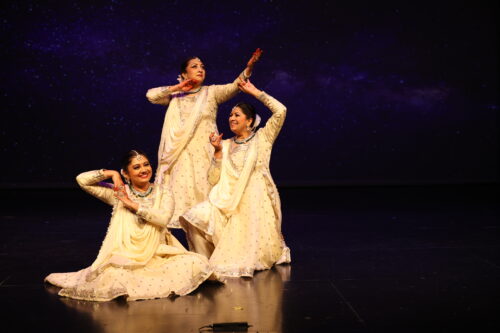
According to the Sangita Raknakara, a definitive musicological text from 13th century India, when vocals, instruments, and dance come together, “music is born.”
On a recent mid-fall evening at the Kaplan Theater at the ERJCC, Kalpana Subbarao and her collaborators prepared to share the virtuosic rhythmic compositions and choreography that made up the 5×5 program, and the audience settled in to enjoy a seventy-minute program of uncommon breadth.
The evening began with a welcome from Mistress of Ceremonies Lalita Khemka before Subbarao took the podium to outline the 5×5 concept: five musical sources and five rhythmic selections in the format of a solo Kathak dance concert. This description alone signals two special features of 5×5. First, solo-concept Kathak performances are rarely seen in Houston. Second, the usual number of rhythms in a Kathak performance is one. The audience knew it was in for a rare treat.
Shiva Nataraja, The Divine Cosmic Dancer
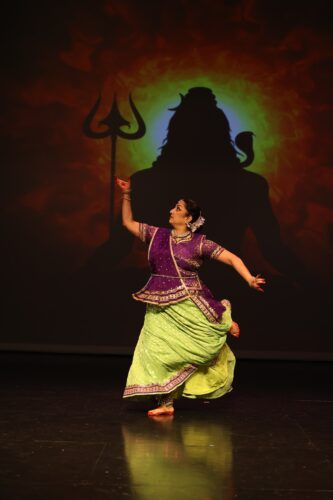
The first dance was an invocation to Lord Shiva, The Divine Dancer, whose presence would connect dancers, musicians, and audience in sacred unity.
The resonance of sitar strings masterfully plucked by Dr Rajarshi Bandyopadhyay opened the rich feast of sight and sound in melody with Dr Jyoti Joshi’s harmonium and Jason Zinn’s tabla. Vocalist Shyama Mistra, like all the musicians working with Subbarao, is a local treasure capable of connecting contemporary audiences to classical Hindustani music.
Subbarao was the solo Kathaka (Kathak dancer) in this piece, and her movements both built and inhabited whole worlds.
Shiva was certainly present.
Four Sections, Four Beats, Unlimited Variations
The second piece was choreographed by Subbarao and her guru Pandit Sotosh Maharaj and was the first example of Subbarao’s taal (rhythmic constructions) artistry. The first of the four sections was based on a metered poem describing the monsoon season, and Subbarao created curtains of rain, flowing paths turned streams, and a restful, alert joy of those whose world has temporarily turned to water, but who know that a fertile time is ahead.
In these four sections, the magicianship of the Kathaka and Padhant (reciter of syllablic tempos) was on show. I am not the first reviewer to make this comparison, but it is apt because the Padhant tells you the impossible thing they are about to do, and then, as Kathaka, they do it! Subbarao took the taals, put them in a box, cut them in half, and reassembled them with her feet. She made the stage disappear with a deft movement of her eyes. No smoke, mirrors, or misdirection; this is the art of Kathak.
Krishna as a Girl
If you live in a gorgeously multiethnic city like Houston and you don’t attend cultural arts events, you miss out on quirky, resonant, and ancient stories like this one: Fed up with Krishna’s teasing, one of his devotees decided to get him back by coaxing him into a deep sleep and then dressing him as a girl. The plan worked, except once the disciple clothed Krishna they realized that, even dressed as a little girl, neither the god’s beauty nor his divinity had diminished one bit. A lesson is learned about the irreproachable nature of the gods and the futility of trying to besmirch the sacred.
Musically, this piece is based on a Hindi folk song from the ancient land of Braj, the birthplace of Lord Krishna. To me, the choreography was more direct and the distance travelled by the dancer was smaller than in some of the other pieces that ranged across the stage. There were playful moments, but the overall feeling was the quiet intimacy of devotion.
I should mention the costumes worn to this point by Subbarao and her fellow dancers, Neha Shah and Vruti Patel. Classical Indian performance dress is rich, precise, layered with meaning, and highly ornamented. Textured green silk with colorful and metallic borders paired with green stones in sparkling settings. Dancers also wore red Mendhi designs on hands and feet, every part of the body primed to express elements of the varied and intense program designed by Subbarao.
Raga – a Vein; a Fiber; Poison; Hue; to Color the Mind; Musical Harmony; an Attachment or Desire
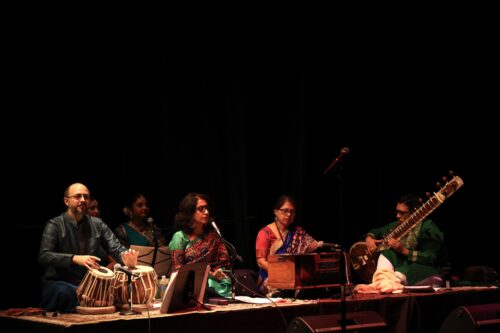
Yes, raga has many meanings, at least one in most of the many languages and dialects of India. In my overall ignorance of these meanings, I can say that the music in this selection was accompanied by an image of an astronomical scene that must have come from a powerful telescope. Stars and their galaxies spread to infinity across a purple-blue universe. This raga paired perfectly with contemplation of the heavens.
Urdu Ghazal
Kathak’s northern Indian origin means that it was strongly influenced by the Mughal presence in the 12th through 17th centuries when Urdu became the official court language of the empire. A form of romantic poetry, the ghazal was developed in the early 1700s and remains popular with lovers today. The ghazal for this piece is about lovers leaving and returning to each other, and the hope that their love will win in the end.
True to the Persian Mughal influence of the time, the costume changed for this piece. Subbarao’s dress was shorter, red with a metallic print, and worn with white pants. She also wore a Karakul-style black hat with a purple feather and white ornament.
The choreography of the piece described the joyous joining of two into one, and processes of searching, desiring, preparing, and selecting. The sound and movement grew in intensity to a sweet resolve.
Madhya/Drut – Medium/Fast
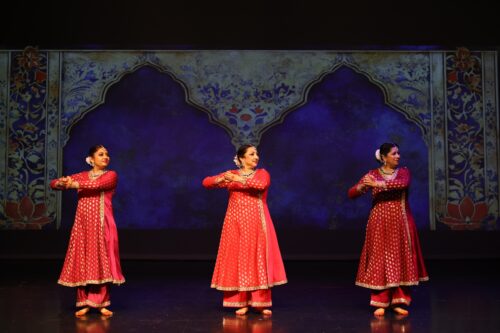
The title of this section was a warning: hang on to your hat. Nothing slow or calm, here. Only medium and fast. Four composition styles in three rhythms by five composers and three choreographers redefined Kathak virtuosity.
All three dancers participated in the several sections of this piece, all wearing Persian-style dress in shades of red, and Subbarao performed complex taal full of breaks and pauses that made the audience hold their own breath as their hearts pulsed to the robust rhythms. One section mimicked the percussive sounds of instruments, and another balanced a rhythm that was “masculine and forceful” with one that was “feminine and lyrical.” The dynamic force and complexity of this penultimate section left the crowd energized for the final piece.
“My Soul is on My Lips”
The final selection is based on a 13th century Sufi song, a Tarana, arranged by Subbarao and her musician collaborators. The lyrics speak of the moment of death when one’s soul escapes the body, and it speaks also of love and of devotion to the beloved. The dying lover sings
My soul has come to my lips (I am on the verge of death)
Come to me so that I may remain alive –
After I am no longer… what is the purpose of your arrival?
O love/my beloved, come soon, come at once
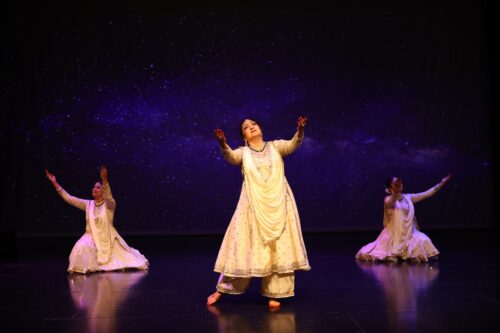
The costumes were now white with silver motifs that glittered like stars under the colorful stage lights as the dancers swirled, dervish-like, in elliptical patterns of the cosmos after leading us through movements of yearning and choreography that was more tied to the instrumentation than in any other choreography of the evening.
After an evening of exquisite rhythm and moving melody, soaring sounds and emotional gesture, the audience was on their feet in appreciation, and afterward swarmed the stage with thanks and well-wishes for the exhausted performers.
Kalpana Subbarao and her collaborators accomplished their solo-style Kathak evening of virtuosic rhythm presentation, and the Houston audience was delighted. Conversation after the performance was unanimous about wanting to see more such risk-taking, experimental work done with treasured classical themes, as well as gratitude for the journey we had gone on that evening, which we would take again in a heartbeat.



Recent Comments